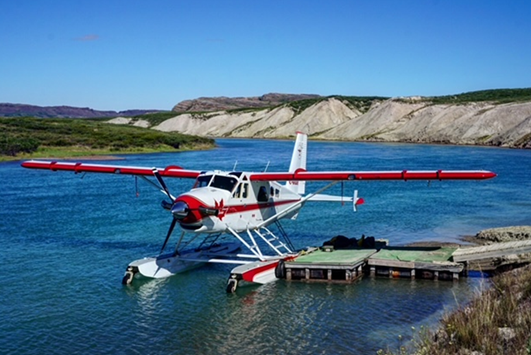by Bry the Dunker Guy, Kevin Elwood & Doug Ronan
Spring has passed and summer is here, so where are the floatplanes we hold so dear?
Photo credit: Kevin Elwood.
Seaplane beside dock
They are coming out of hangars, barns and offshores of lakes, but what might have happened since last we flew to increase the stakes.
Simply put, we must realize, even when sitting in a warm dry building, aircraft may still be subjected to mice who decided a tail section may be a great home for winter.
As well with all the movements involving other machines over the past several months, wing tips and surfaces such as ailerons could have been bumped, bent, or bruised.
Prior to your first flight, a thorough check out of your prized possession, which should include more than looking over not only the bird droppings on wings is required.
This should be followed by a complete control check to be certain moving parts are doing exactly what they were originally designed to do.
The ELT should be tested for competency, as well battery life and, in the event your aircraft has been outside for any appreciable time, bird nests which are often found at a variety of locations.
Obviously, any maintenance required above and beyond the normal must be completed annually.
All of this should be followed by a reasonably long warm up then shut down, confirming mag drops and oil pressures or leaks have been noted.
Water in fuel has brought down more than one aircraft shortly after take-off on its first flight of the season, especially bad timing as not only the machine was ill prepared but as well the pilot.
You have to admit first flight after a long break from being at the controls leaves a bit of guesswork as to where certain gauges are located.
Be patient as it may take a while to recall where they are all on a moment’s notice until muscle memory returns.
For those of us who fly year-round with wheels or skis fitted to the undercarriage, it’s not such a huge transition, although the latest change in wheel to eyes height has fooled more than one aviator.
With that being said, a checkout from a pilot with more recent experience may be money well invested.
Once back in the saddle, so to speak, when your confidence is fine tuned for the season, it’s time to consider your passengers.
They often have little interest in flight and more only in arriving at a destination, thus a lesson in aircraft etiquette is in order.
A pre-flight briefing is imperative for each and every person who flies with you as their survivability is greatly enhanced when there is no warning prior to an accident.
Explaining how the doors operate and where each one is, including emergency exits and any roof hatches if applicable, is an absolute necessity in the event the pilot is incapacitated.
Also include mention that you never exit the aircraft until the aircraft engine has been shutdown and aircraft secured to the dock.
As per above information, float pilots are not only required to indicate where personal floating devices (PFD) are located, but also how to wear them and when to inflate them in the unlikely event they are required.
Plus, an understanding of where first aid kits and other items such as fire extinguishers are located should be mentioned. Always bring to their attention that seatbelts must be fastened with the buckle facing outwards, similar to the airlines’ rendition prior to flight.
This is particularity important for the non-frequent flyers who would instinctively head for whatever hip release their Honda belts were installed with.
Remember, even though you may not be a commercial operator, there is still a professional standard to be adhered to, as you are responsible for each and every soul entrusted to you in flight.
The fact is that, with float flying, there are far more variables to be contended with each flight than when operating on wheels.
First off, a windsock is often the flag hanging in someone’s front yard or being able to read the wind direction off of the water surface a thousand feet below.
While taxiing out of a marina, you are more prone to be guided by mother nature between those other vessels in whatever wind speed and direction provided, without the ability to stop.
The same goes for docking on a moving river or strong tidal waters, again with a wind that may be less than helpful.
Unlike a runway, water surfaces change constantly from rough to glassy and everything in between, some more demanding than others.
Then there are the retractable gear aircraft, including amphibious seaplanes and flying boats, where a checklist is highly recommended to avoid a costly mistake, which could be life threatening.
For all commercial pilots operating seaplanes or flying boats, be advised that, as of March 6, 2023, Egress Training is now mandatory, and highly recommended for private pilots as well.
Fly safe and have fun this summer.
